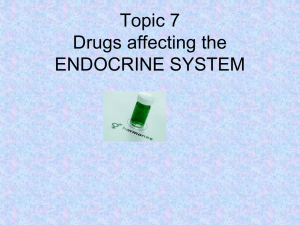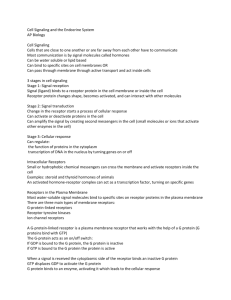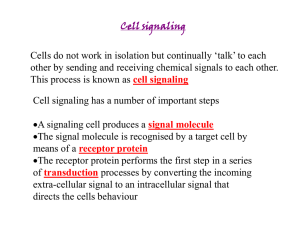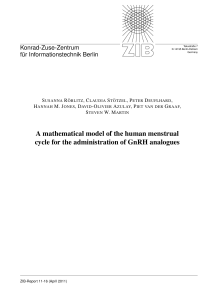bio310 test 1 answers
advertisement
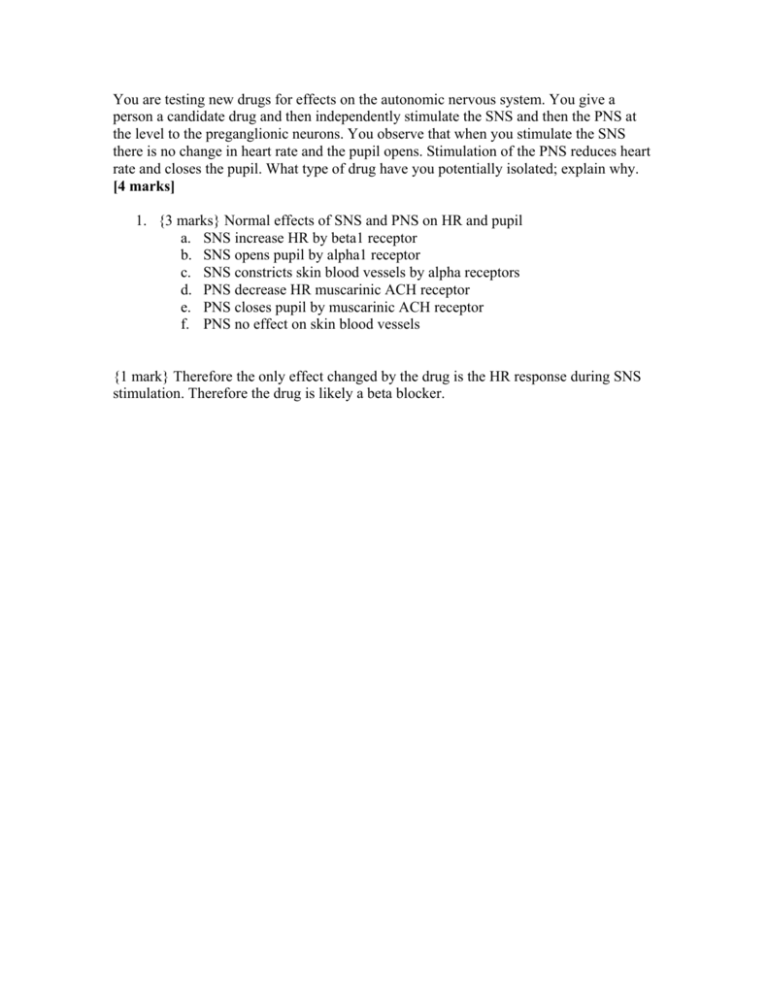
You are testing new drugs for effects on the autonomic nervous system. You give a
person a candidate drug and then independently stimulate the SNS and then the PNS at
the level to the preganglionic neurons. You observe that when you stimulate the SNS
there is no change in heart rate and the pupil opens. Stimulation of the PNS reduces heart
rate and closes the pupil. What type of drug have you potentially isolated; explain why.
[4 marks]
1. {3 marks} Normal effects of SNS and PNS on HR and pupil
a. SNS increase HR by beta1 receptor
b. SNS opens pupil by alpha1 receptor
c. SNS constricts skin blood vessels by alpha receptors
d. PNS decrease HR muscarinic ACH receptor
e. PNS closes pupil by muscarinic ACH receptor
f. PNS no effect on skin blood vessels
{1 mark} Therefore the only effect changed by the drug is the HR response during SNS
stimulation. Therefore the drug is likely a beta blocker.
Compare and contrast the way that lipid-insoluble and lipid-soluble hormones control
cellular activity. Outline a general framework and then specifically use Thyroid
Stimulating Hormone (TSH) and thyroid hormone as examples to provide details on how
these hormones function. [8 marks]
{2 marks] Lipid insoluble hormones must work through a membrane receptor. When the
hormone binds the receptor a G-protein is activated. This can stimulate or inhibit activity
of other molecules such as adenylate cyclase or phospholipase C. These in turn regulate
production of second messengers (Ca++, cAMP, cGMP, DAG, IP3). In turn these
regulate effectors (protein Kinase A, C, G), ion channels, other enzymes which regulate
cell function. Short time (seconds, minutes)
{2 marks} Lipid soluble hormones pass through the cell membrane and interact nuclear
or cytoplasmic receptors. The hormone receptor complex goes into the nucleus where it
regulates gene transcription and leads to protein production. Long time (hours, days)
{2 marks] TSH interacts with receptor to stimulate G-protein and activate adenylate
cyclase, increases cAMP, increases PKA, activates i) thyroglobulin breakdown, ii) iodine
pump activity, iii) rate of iodination
{2 marks} Thyroid hormone interacts with a nuclear receptor and is involved in
activating many genes. Two are Na/K ATPase (pump) and glucose transporters. Thyroid
hormones increase metabolic rate and increase beta adrenergic receptor responsiveness.
3. Describe the hormonal control of sperm production and explain what would happen in
a male who takes large quantities of testosterone-like steroids. [8 marks]
{1 mark each}
1. GnRH from hypothalamus leads to ↑ FSH and LH from anterior pituitary
2. LH acts on Leydig cells causing them to produce testosterone
3. Testosterone required in sertoli cells to support spermatogenesis
4. FSH acts on sertoli cells; they support spermatogenesis and produce inhibin
5. The testosterone provides negative feedback reducing GnRH, and LH
6. inhibin from seroli cell inhibits FSH
{2 marks}
7 & 8. Large amount of testosterone-like steroids would increase negative feedback to
anterior pituitary (LH) and hypothalamus (GnRH). This would lead to decreased GnRH,
decreased FSH and LH and therefore decreased sperm production. Thus, such a person
might be infertile
MULTIPLE CHOICE
- SELECT BEST ANSWER
- ANSWER ON SCANTRON
1. Homeostasis refers to
A. Physiological parameters that do not change.
B. maintaining a stable internal environment.
C. maintaining a stable external environment.
2. The steady state value for any variable that the body attempts to maintain is the
A. set point.
B. equilibrium potential.
C. error signal.
D. reflex arc.
3. If the amount of sodium in the blood decreases, then a negative feedback control
mechanism would be expected to
A. decrease the amount of sodium in the blood.
B. increase the amount of sodium in the blood.
C. leave the amount of sodium unchanged.
D. change the set point for sodium
4. Hormones
A. are chemical regulators that are conveyed from one organ to another via the
blood stream.
B. may be secreted by endocrine cells.
C. may be secreted by nerve cells.
D. All of the choices are correct.
5. Heart rate is affected by the release of epinephrine from the adrenal medulla into the
bloodstream. This is an example of
A. endocrine control.
B. exocrine control.
C. paracrine control.
D. direct neural control.
E. none of the choices are correct.
6. A major function of plasma membranes is to
A. store calcium ion.
B. regulate the passage of molecules into and out of the cell.
C. provide genetic information.
D. generate ATP.
7. Carrier-mediated transport
A. involves a specific membrane protein that functions as a carrier molecule.
B. always involves the movement of substances against a concentration gradient.
C. always requires the direct expenditure of energy.
D. All of the choices are correct.
8. Which of the following statements about the Na,K pump is false?
A. It transports Na+ out of cells and K+ into cells.
B. It transports Na+ and K+ in a 1:1 ratio.
C. It is constantly active in all cells.
D. Its activity requires the expenditure of metabolic energy.
E. It binds to and hydrolyzes ATP
9. Which of the following are ways in which a chemical messenger can cause an
intracellular response?
A. opening or closing of specific ionic channels in the plasma membrane
B. activation of an intracellular second-messenger system
C. promoting or inhibiting the transcription of genes that code for the synthesis of
cellular proteins
D. All of the choices are correct.
10. Oxytocin is a peptide hormone that causes the smooth muscle of the uterus to
contract, but it has no effect on the smooth muscle cells of the small intestine. This
difference in response exists because
A. oxytocin is inactivated prior to reaching the smooth muscle cells of the
intestine.
B. intestinal smooth muscle cells do not contain the proper second messenger
system.
C. uterine smooth muscle cells contain specific receptors for oxytocin.
D. oxytocin is not delivered by the circulatory system to intestinal cells.
11. Amplification during a second messenger cascade is beneficial because amplification
A. takes small molecules and makes polymers out of them.
B. results in the production of more of the first messenger.
C. allows a cell to respond to more different hormones.
D. allows small amounts of hormones to produce large responses in target cells.
E. None of the choices are correct.
12. The second messenger that causes calcium ion to be released from intracellular stores
is
A. Diacylglycerol (DAG).
B. adenylate cyclase.
C. inositol triphosphate (IP3).
D. phospholipase A.
E. cyclic AMP (cAMP)
13. During the depolarizing phase of a neural action potential, voltage-gated
A. Na+ channels open.
B. K+ channels open.
C. Na+ channels close.
D. K+ channels close.
14. The regions of axon membrane that lie between regions of myelin are the
A. islets of Langerhans.
B. nodes of Ranvier.
C. synaptic membranes.
D. glial cells.
E. dendrites.
15. The role of calcium ion at chemical synapses is to
A. depolarize the axon terminal of the presynaptic cell.
B. bind to neurotransmitter receptors on the postsynaptic cell.
C. cause fusion of synaptic vesicles with the plasma membrane of the axon
terminal.
D. All of the choices are correct.
16. The hormones secreted by the posterior pituitary include
A. vasopressin.
B. corticotropin.
C. oxytocin.
D. vasopressin and corticotropin.
E. vasopressin and oxytocin.
17. Thyroid hormones stimulate metabolism by stimulating
A. lipid synthesis.
B. the Na/K ATPase.
C. action potentials.
D. cell division.
18. Why is radioactive iodine (I131) an effective treatment for thyroid cancer?
A the blood stream delivers iodine directly to the thyroid
B. the follicle cells are more sensitive to I131 than other cell types
C. the sodium/iodine cotransporter concentrates iodine in the follicle cells
D. iodine is not required elsewhere in the body
19. Which of the following tissues is most dependent upon a constant blood supply of
glucose?
A. brain
B. adipose tissue
C. skeletal muscle
D. cardiac muscle
20. What is the action of increased insulin level on cells?
A. increases the uptake of glucose by muscle and adipose-tissue cells.
B. increases the utilization of glucose by nerve cells.
C. decreases the uptake of amino acids by muscle cells.
D. decreases the uptake of glucose by liver cells
21. Glucagon secretion is stimulated by
A. high blood glucose.
B. low blood glucose
C. activation of the sympathetic nervous system.
D. A & C
E. B & C.
22. The major metabolic effects of glucagon include
A. promoting glycogenolysis and gluconeogenesis in the liver.
B. promoting lipolysis in adipose tissue.
C. promoting glucose uptake into skeletal-muscle.
D. all of the choices are correct.
23. After fertilization of the egg the trophoblast maintains the corpus luteum by secreting
A. large quantities of FSH and LH.
B. GnRH, which stimulates the pituitary gland to secrete FSH and LH.
C. Human chorionic gonadotropin.
D. progesterone and estrogen.
E. all of these things.
24.Granulosa cells in the ovaries are functionally similar to which cells in the testes:
A. Leydig cells
B. Sertoli cells
D. Thecal cells
25. The key hormonal event immediately prior to ovulation is
A. greatly increased estrogen production
B. a decreas in GnRH secretion
C. an increase in progesterone secretion
D greatly increased secretion of LH
26. The secretion of which two hormones is linked to ATP-sensitive K+ channels are:
A. cortisol and insulin
B. cortisol and parathyroid hormone
C. insulin and ACTH
D. estrogen and testosterone
